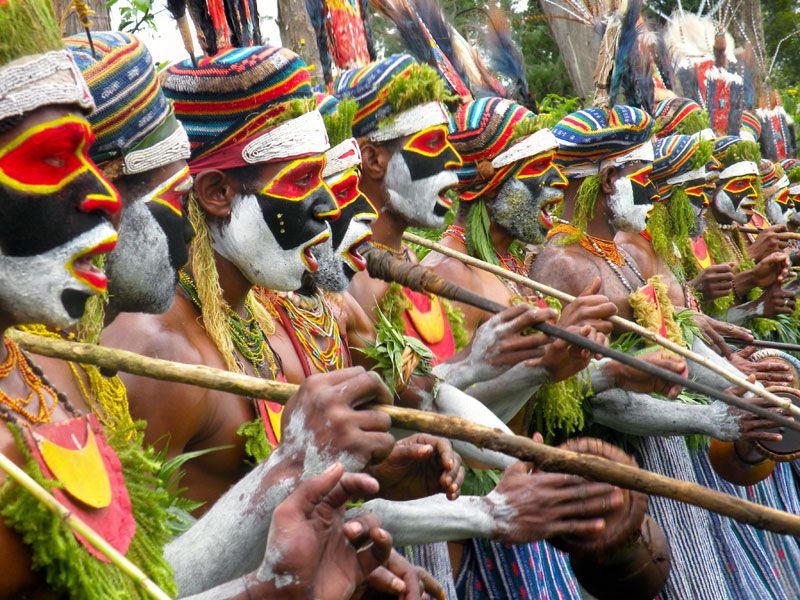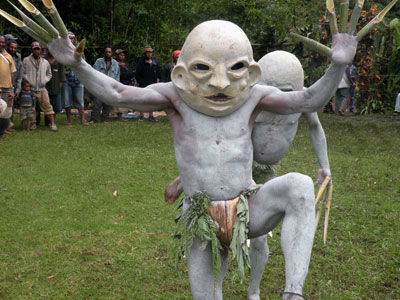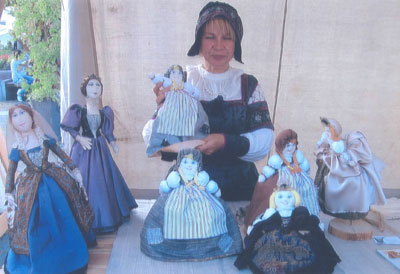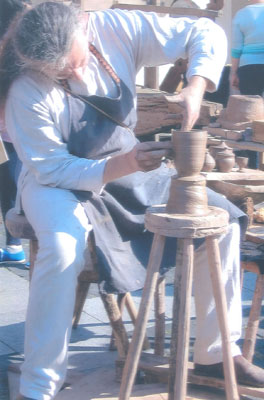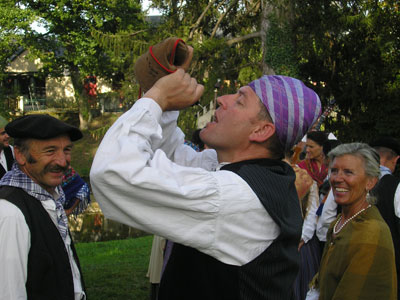Annual themed festivals (3 of 3)
We asked you to tell us about a fun, impressive or unique annual festival, celebrating something in particular, that you attended outside of the US in the last few years. We requested the name of the festival, where it takes place, when it takes place and for how many days plus the year you went. We also wanted to know what activities occurred, what you experienced, approximate costs, tips on how to get to the festival and any other helpful advice.
Responses were printed in the last two issues. In this final part, travelers describe festivals in, mostly, EUROPE, with one entry on OCEANIA (Papua New Guinea). If you are an ITN subscriber and have an event to share, write to Annual Themed Festivals, c/o ITN, 2116 28th St., Sacramento, CA 95818, or email editor@intltravelnews.com. Include the address at which you receive ITN. Photos are welcome.
The best of all festivals* that I’ve ever witnessed is the annual Tumbuna Sing-Sing in the Paiyagona Valley in central PAPUA NEW GUINEA. This event unquestionably ranked number ONE for satisfying my traveler’s inquisitiveness.
The festival, with extreme body painting, feathered costumes, thunderous dancing, husky singing echoes and merrymaking with flutes and drums, is an eyeball cardiac arrest. In short, it is possibly one of the best human performances on Earth.
It was fun and easy to photograph some of the most fierce-looking — but also smiling — people I’ve ever seen. And nobody nickeled and dimed the photo takers to death, as members of many other cultures do. In fact, the entire tour had a “no tipping” policy.
Our tour with New Guinea Travel departed on May 11, 2010. We had guided walks, guest speakers and access to villages so remote that no roads went to them. The sing-sing was the finale.
Our group was limited to 14 people. Excluding domestic and international airfare, our 13-day adventure cost, then, $7,600 per person, twin share.
This may appear expensive, but pick your fondest travel destinations, the best of your life, and you will find that they cost a considerable amount of money. Few tours provide memories like these. They are indelible.
No other people I have ever visited had more interesting collectible artworks of a primitive nature than those in the Sepik River communities.
Don’t wait too long to enjoy this exciting festival. Papua New Guinea is changing quickly.
Larry Kritcher
Coconut Grove, FL
*Unlike other sing-sings in Papua New Guinea, the Tumbuna Sing-Sing is a privately organized sing-sing available only to group members of tours with New Guinea Travel (Santa Barbara, CA; 800/676-1241, www.pngtravel.com) and Trans Niugini Tours (Mt. Hagen, Papua New Guinea; www.pngtours.com). The 2016 Tumbuna Sing-Sing will take place on May 20, and the excursion with New Guinea Travel begins May 10 and costs $9,100 per person, twin share, excluding airfare.
New Guinea Travel owner Greg Stathakis told ITN, “Papua New Guinea’s largest sing-sing, by far, is the one at Goroka. It is a 3-day festival, it can have up to 70 groups of tribespeople performing (12 to 25 per group), and it can be attended by fewer than 100 foreign visitors and expats (limited accommodations) but up to 10,000 locals. The 2-day sing-sing at Mt. Hagen can have up to 35 groups of performers, with nearly 300 foreign visitors and 10,000 locals attending. The one-day sing-sing at Tumbuna can have a dozen groups of tribespeople, a few dozen foreign visitors and up to a hundred locals.”
While visiting CROATIA in May 2012, my husband, John, and I discovered that, quite by accident, our brief time in Split would coincide with that city’s biggest festival day, Sveti Duje’s Dan (St. Domnius Day), which is always on May 7.
We were particularly fortunate that a family member put us in touch with a resident who offered to show us around when we arrived in town. We stayed at a boutique hotel in the Diocletian’s Palace area, which was a perfect location for a festival visit.
Split really took on a joyful air. Flowers, balloons and banners decorated the Old Town. The Riva, a promenade between Diocletian’s Palace and the beautiful Adriatic, was crowded with booths offering food, crafts and mementos, in particular, heart-shaped sugar cookies and small wooden spoons.
A religious procession made its way from the main cathedral to a stage set up at one end of the Riva. There, Mass was said in Croatian by several priests to a standing audience of hundreds. Our new friend (who, like many Croatians, spoke English) translated for us.
There was music all day. The large and lively crowds were not daunted by the heavy rain that continued for much of the day. They just whipped out big umbrellas or scurried under restaurant awnings.
At night, many young people gathered on the seawalls by the Riva to watch the fireworks. We were able to watch from a restaurant on the Riva.
Almost magically, Split returned to everyday life the next day, with the booths and crowds disappearing. We were very glad to have been a part of Split’s most important festival.
Sandy Elligers
McLean, VA
After years of planning to visit the Baltic capitals, I picked the weekend of Aug. 23-25, 2014, for Vilnius, LITHUANIA.
After happily settling into my room, I wandered forth and, in the Town Hall Square, happened upon the annual Bartholomew Fair, on St. Bartholomew’s feast day, celebrating Grand Duke Alexander’s acceptance of the first crafters’ guild charter on Aug. 24, 1495.
Potters, blacksmiths, woodworkers, bookbinders, candle makers, weavers and bakers, all in medieval costume, were demonstrating their skills and selling their goods. They invited children to try their hand (and feet) at the potters’ wheels, to bind small books and to examine the raw wool awaiting the spinning wheels.
To add to the merriment, dancers and musicians performed, and beer and food were available at trestle tables. Children of all ages were enjoying the festive hubbub on the sunny summer day.
Arrival in Vilnius was easy. At the airport I changed €5 (then, about $7) into LTL17.15* so I would have Lithuanian lats for the bus to town. It stopped at the square by the train and bus stations, and it was an easy one-kilometer walk to my hotel, Domus Maria (Auštros varty str. 12, Vilnius; phone +370 5 264 48 80, http://domusmaria.com/en/hotel). Its location by the Gate of Dawn at the entrance to Old Town was perfect.
My single, with facilities en suite (including a strong, hot shower), cost €67 per night. It was clean, comfortable and simply furnished, and the friendliness of the employees added to the welcoming atmosphere.
The included breakfast buffet was so extensive that the only other food I needed all day was some fruit, cheese and trail mix in the evening.
That weekend included other anniversaries. August 23 was the 25th anniversary of the Baltic Way, the human chain that linked Vilnius with Riga and Tallinn in protest against Soviet occupation in 1989. Also, on Aug. 24, groups gathered and Masses were held in support of Ukrainians on their Independence Day.
Helen Harper
Mill Valley, CA
*Lithuania adopted the euro as its currency on Jan. 1, 2015.
One of the most pleasant and unforgettable experiences that my husband and I had in ITALY was attending the Sagra del Tordo (Festival of the Thrush) in Montalcino in 2003. Started in 1958 and held on the last weekend each October (2015 dates are Oct. 24-25), the festival celebrates the thrush, historically significant in this area.
We found a place on the piazza in the afternoon and watched a colorful procession composed of about 150 men and women wearing costumes fashioned on those of the 14th to 15th centuries. They were accompanied by the blare of trumpets and drums.
The procession ended at a piazza with many food and wine stalls. Typical products and dishes included pappardelle (a flat noodle) with wild boar and pinci (a hand-rolled pasta) sauce plus grilled meats and bean soup, all accompanied by wines of Montalcino.
While we were sitting in the bleachers enjoying our grilled “thrush” (chicken, actually), two local couples sat near us. They invited us to join them, refilling our wine glasses and sharing laughs, although they spoke little English and we spoke very little Italian.
Marsha Caplan
Boulder, CO
Each time I visit family in Calabria, ITALY, during the month of August (most recently in 2010), there are two religious festivals that I attend. Both involve all of the villagers as well as visitors taking part in a procession and subsequent celebration.
• The first, the feast of Maria Sanctus del Soccorso (Sacred Maria of Help), takes place the second Sunday of August in Sorianello in the province of Vibo Valentia.
It begins in late afternoon with the crowd gathering just outside the church awaiting the exit of the statue of the Sacred Heart of Mary. Followed by a brass band, the statue is borne throughout the main roads of this mountain village. The priest usually leads people in prayer.
Sorianello was built on the mountainside right above Soriano during the times of Saracen invaders, and in a Vatican museum I noted the village of Soriano on a map dating back to the year 1000.
This religious festival may have originated as a thanksgiving to the Blessed Mother for favors received, possibly relief from invaders or the plague.
• In a neighboring village, Gerocarne, a bigger and much more elaborate festival, St. Rocco’s feast, takes place the first Sunday after the 16th of August.
St. Rocco was from a noble family in Montpellier, France, and he worked as a nurse during the plague. He is well known and venerated throughout southern Italy.
The festival in Gerocarne begins with Sunday Mass and a procession with the statue of the saint. Just outside the church, a brass band waits for the villagers to exit from Mass, after which the band starts and the statue is borne outside the church with the priest leading the way.
The procession winds around this little village and then places the statue in a small chapel in a wooded area just outside the village. The band members stay with the statue until evening, when the celebration begins again in full force.
Placing the statue in the small chapel commemorates the time St. Rocco stayed in the woods after working in various villages. A dog that lived nearby would take a loaf of bread from his master to the saint each day. As a matter of fact, the statue also depicts this little dog with a loaf of bread in his mouth alongside the saint.
The statue is taken back to the village just as evening falls, and the village is lit up with festival lights. The band plays, and a massive fireworks display takes place. There are vendors selling beautiful ceramics and toys. Of course, the gelato shops are open.
Both of these festivals are quite fun, and joining the procession is a great way to tour the villages on foot.
The scenery is just wonderful — settled in the mountainsides, the villages date back to the early Middle Ages, with narrow passageways and arches. It is also touching how the traditions have continued through the many generations.
To get to these festivals, I recommend staying in nearby seaside Pizzo or Vibo Valentia (capital of the province), where there are many hotels. Buses can take you to the above villages or a private car may be arranged. If staying in a hotel, concierges can certainly guide you as to what transportation is convenient.
Maria C. Ciancio
Ossining, NY
One festival that I’ve enjoyed takes place every August in Edinburgh, SCOTLAND: the Royal Edinburgh Military Tattoo. It starts with a tattoo, a performance of military music, and runs for three weeks with additional events.
When I went, in 2000, it had so many events that I think the program was over 50 pages long.
Original plays, authors each discussing their latest published opus, symphonies, dance performances, art exhibits and whatever comes to mind: it was all there. You can’t go wrong spending time in Scotland at that time of year.
Philip H. De Turk
Pinehurst, NC
Edinburgh’s tattoo takes place Aug. 7-29 in 2015 and Aug. 5-27 in 2016.
In Ieper (Ypres), BELGIUM, the Kattenstoet, or Cat Parade, is held every three years on the second Sunday of May. I visited the 2009 festival and recommend it.
The origins of this festival may date back as far as the 1100s, certainly to the 1400s. During that time, wool and flax and then the woven cloth were stored in towers. Mice were attracted to the cloth and would damage or destroy the fabrics before they could be shipped. Townspeople put cats in the towers to control the mice, but then the cats multiplied.
The solution, gruesome as it may sound, was to throw the cats out of the towers once the cloth had been removed.
The Cat Parade celebrates cats, but after the parade, the city fool throws toy cats down from the hall tower.
Local children, who serve as ushers, dress as mice, and displays throughout the town feature cats.
Reserved seats were available for €16-€22 (near $17.50-$24). I ordered mine through the festival’s website, www.kattenstoet.be/en/home.html, and picked the ticket up on arrival in Ieper.
Lynn Boreson
Madison, WI
In Aramits, located in the foothills of the Pyrénées on the edge of the Basque region of southwestern FRANCE, the Fête des Bergers (Feast of the Shepherds) takes place on the third weekend of September. Preliminary events, in particular the descent of the flocks from summer pastures, take place on the preceding Thursday and Friday.
Visiting in 2013, my husband, Dave Fulk, and I arrived too late for Saturday’s opening parade but still got to see all of the participants in action as the festivities continued.
Attractions included traditional songs and dances by children and by professional groups, exhibitions and sales by local artists and craftspeople, a cheese competition, sheep-shearing demonstrations and the displaying of antique farm implements by their proud owners.
Along with hundreds of others, we enjoyed the Saturday communal evening meal and the song competition that followed. We could have stayed for the late-night Shepherds’ Ball but opted to rest up for the next day’s events.
Sunday featured the true highlights of the event: an open-air Mass in the stadium, with costumed groups (including one group on stilts), shepherds, sheep, the Three Musketeers plus d’Artagnan (real-life musketeer Henri d’Aramitz was the inspiration for “Aramis” in Dumas’ novel) and some of the best musicians in the region as accompaniment, all with the Pyrénées as a backdrop.
After the service, everyone paraded back into town for more song and dance performances. The stilted shepherds stood, paraded and, finally, danced!
The sheepdog competition was held Sunday afternoon. These working dogs were amazing! Not only could they guide a small flock through a complicated obstacle course, some could even herd geese.
Entry to the Fête des Bergers sites was free. Seats for the sheepdog competition cost €10-€12 apiece. Communal cafeteria-style lunches cost €15 (near $16.50) each, and dinner plus the show cost €23. Good wine cost €5 — a bottle, not per glass!
Anyone planning to stay over Sunday night in Aramits should make careful plans for dinner, as we found very few restaurants in the immediate area to be open.
The nearest big city with airport and rail connections is Pau (28 miles or one hour away). There is also a train station in the town of Oloron-Sainte-Marie (8 miles or 20 minutes). It is best to have a car; a taxi from Oloron would be possible but less flexible.
We stayed at the lovely B&B Maison Rachou (64570 Lanne-en-Barétous; phone +05 59 34 10 30 or email rachou948@orange.fr), located in the hills above Aramits and Lanne-en-Barétous. The cost was €53 per night for two.
We are pretty sure we were the only Americans, probably the only non-French and maybe the only visitors who traveled more than 50 miles to see the festival. This total immersion in a very local celebration was priceless. This festival is among the top five experiences of our 40-plus trips to France over 21 years.
Information about the festival can be found at its website, http://aramitsfetedesbergers.fr (in French only).
Mary Rack
Shawnee Mission, KS

